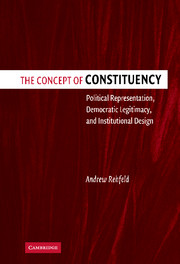 The Concept of Constituency
The Concept of Constituency Book contents
- Frontmatter
- Contents
- List of Tables
- Preface
- PART I CONCEPTUAL FOUNDATIONS: ON CONSTITUENCY AND POLITICAL REPRESENTATION
- PART II HISTORICAL JUSTIFICATIONS: ON THE ORIGINS OF TERRITORIAL CONSTITUENCIES IN THE UNITED STATES
- PART III NORMATIVE APPLICATIONS: ON LEGITIMATE REPRESENTATION AND INSTITUTIONAL DESIGN
- 7 Territory Reconsidered
- 8 Legitimate Representation and Institutional Design: For Permanent, Involuntary, Heterogeneous Constituencies
- 9 Random Constituencies
- 10 Epilogue: The Random Constituency Fifty Years from Now
- Index
10 - Epilogue: The Random Constituency Fifty Years from Now
Published online by Cambridge University Press: 27 July 2009
- Frontmatter
- Contents
- List of Tables
- Preface
- PART I CONCEPTUAL FOUNDATIONS: ON CONSTITUENCY AND POLITICAL REPRESENTATION
- PART II HISTORICAL JUSTIFICATIONS: ON THE ORIGINS OF TERRITORIAL CONSTITUENCIES IN THE UNITED STATES
- PART III NORMATIVE APPLICATIONS: ON LEGITIMATE REPRESENTATION AND INSTITUTIONAL DESIGN
- 7 Territory Reconsidered
- 8 Legitimate Representation and Institutional Design: For Permanent, Involuntary, Heterogeneous Constituencies
- 9 Random Constituencies
- 10 Epilogue: The Random Constituency Fifty Years from Now
- Index
Summary
The arguments of this book have brought conceptual, historical, and normative analysis to bear on the concept of constituency in large, democratic nations generally, and the case of the United States of America particularly. Territorial constituencies may be judged more reasonable and justifiable than I have portrayed them in this book. Proportional representation, whether used in large territorial constituencies or within the nation as a whole, may be viewed with even more charity than I have presented it here, particularly because of the deliberative benefits associated with various electoral systems. And it may be that our thought experiment of Chapter 9 – the random constituency – is too radical an idea ever to be adopted. In this book, I have sought to demonstrate what can be done with the concept of constituency when it is treated on its own terms. None of many options – territorial, racial, ethnic, gender, or ideology – is an unreasonable justification for an electoral constituency, as long as it is publicly justified and well known to the citizens of the polity it purportedly represents. Additionally, I have argued that the default position of permanent, electoral constituencies that look like the nation they collectively represent is stronger than some might have otherwise thought.
I conclude this book in an unconventional manner by taking the discussion of Chapter 9, in which I proposed using random constituencies for political representation in the United States, and asking, “What would an observer of the American system observe were he to visit the nation fifty years after the random constituency was adopted?”
- Type
- Chapter
- Information
- The Concept of ConstituencyPolitical Representation, Democratic Legitimacy, and Institutional Design, pp. 240 - 244Publisher: Cambridge University PressPrint publication year: 2005


